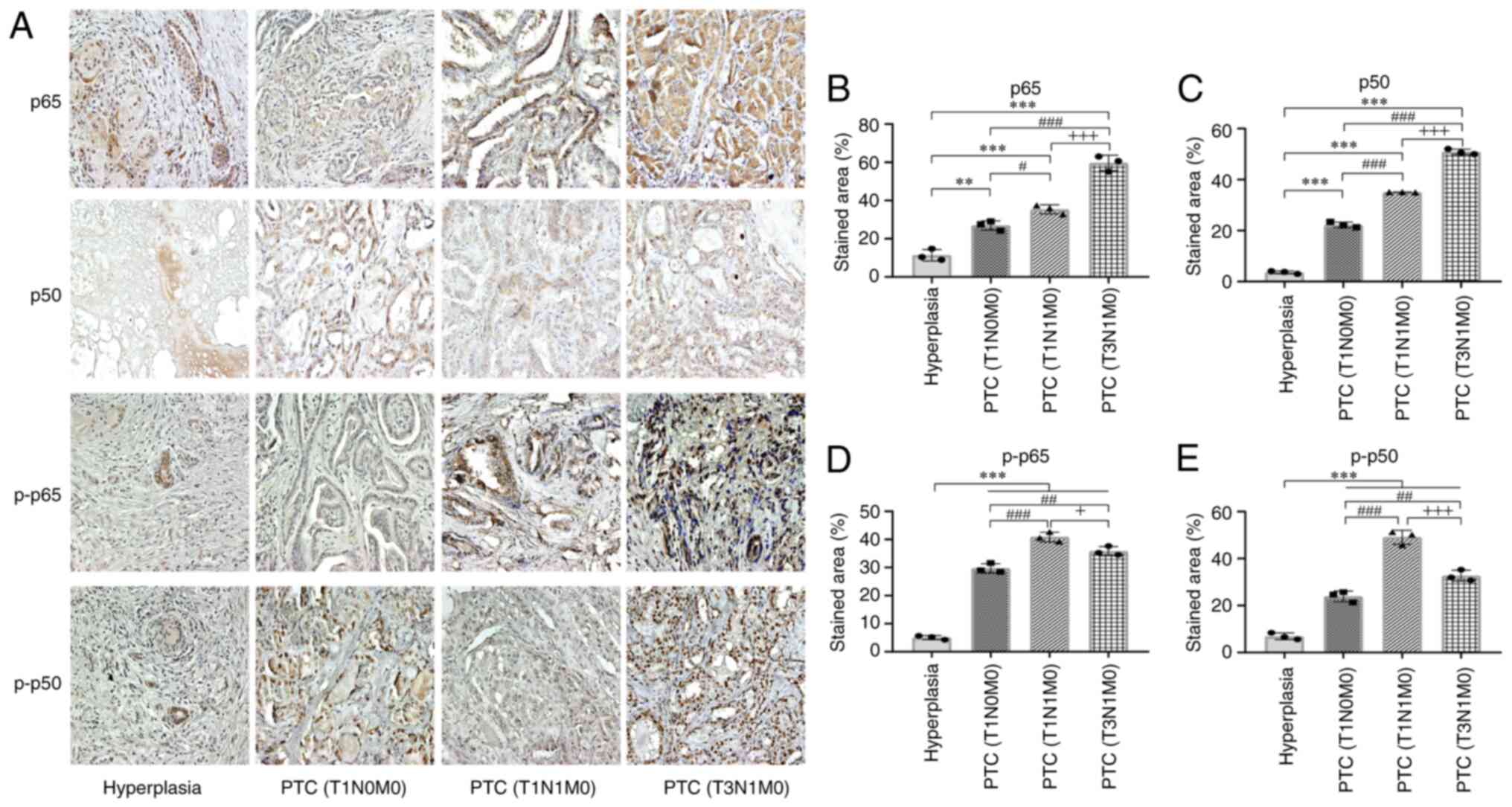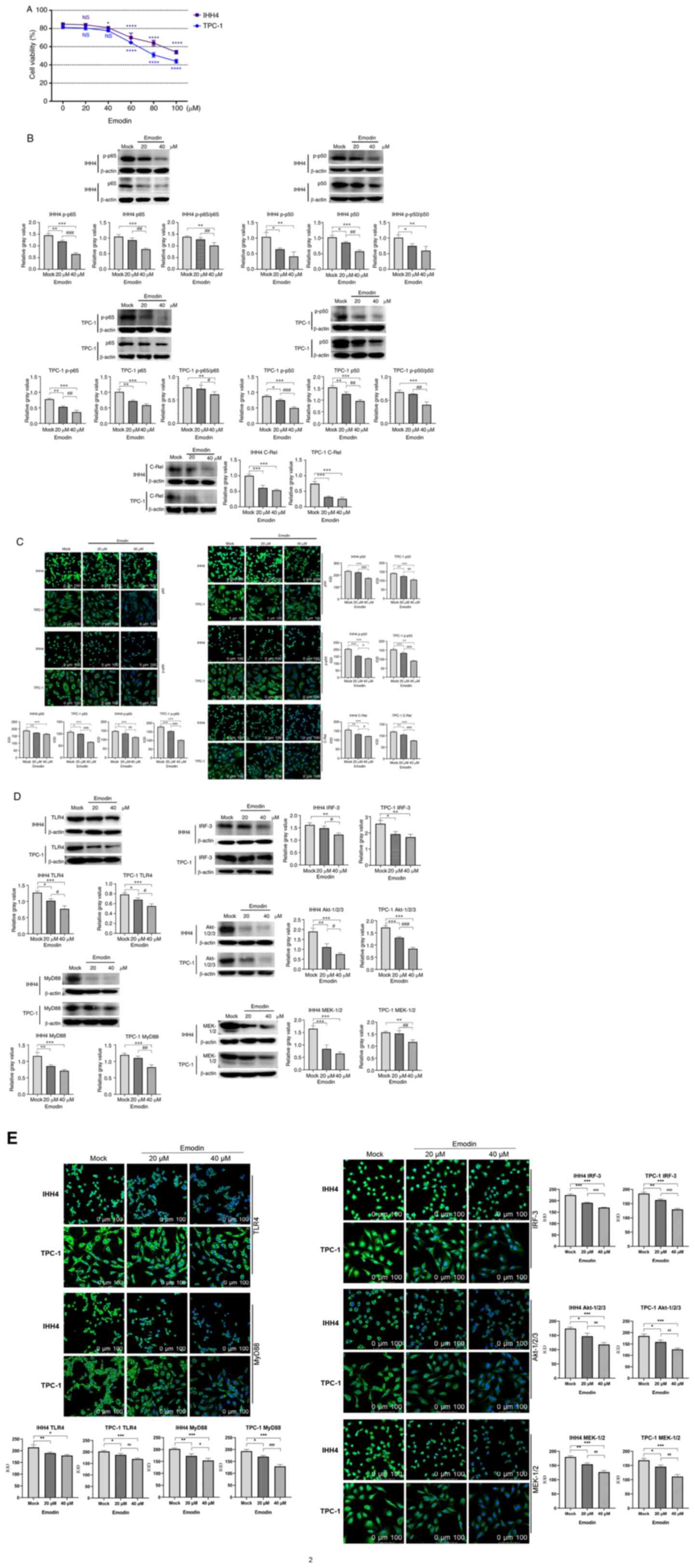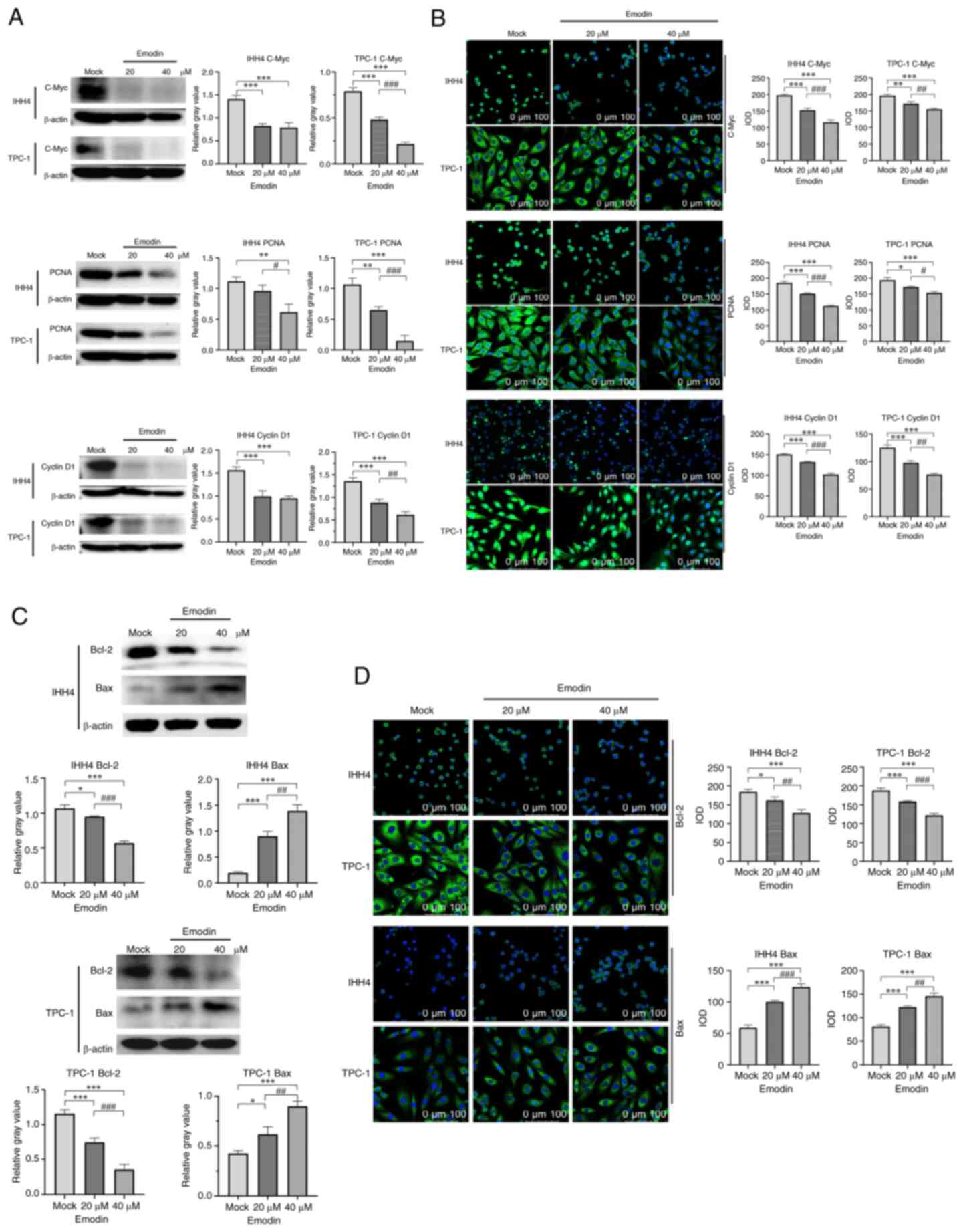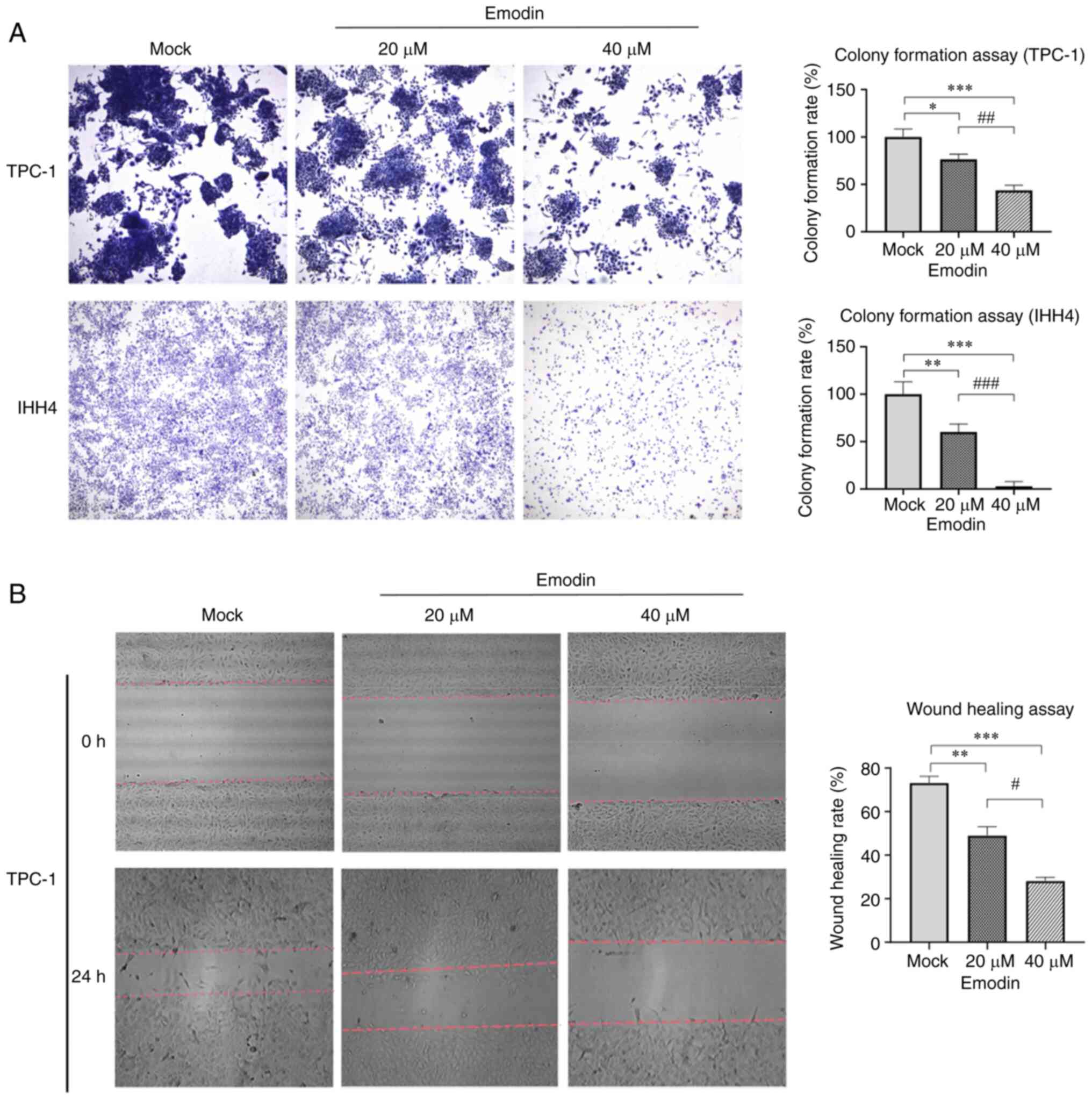|
1
|
Siegel RL, Miller KD and Jemal A: Cancer
statistics, 2019. CA Cancer J Clin. 69:7–34. 2019. View Article : Google Scholar : PubMed/NCBI
|
|
2
|
Lloyd RV, Osamura RY, Klöppel G and Rosai
J: WHO classification of tumours of endocrine organs. 4th edition.
IARC Publications; Lyon: 2017
|
|
3
|
Saini S, Tulla K, Maker AV, Burman KD and
Prabhakar BS: Therapeutic advances in anaplastic thyroid cancer: A
current perspective. Mol Cancer. 17:1542018. View Article : Google Scholar : PubMed/NCBI
|
|
4
|
Fagin JA and Wells SA Jr: Biologic and
clinical perspectives on thyroid cancer. N Engl J Med.
375:1054–1067. 2016. View Article : Google Scholar : PubMed/NCBI
|
|
5
|
Boumahdi S and de Sauvage FJ: The great
escape: Tumour cell plasticity in resistance to targeted therapy.
Nat Rev Drug Discov. 19:39–56. 2020. View Article : Google Scholar : PubMed/NCBI
|
|
6
|
Zeng P, Shi Y, Wang XM, Lin L, Du YJ, Tang
N, Wang Q, Fang YY, Wang JZ, Zhou XW, et al: Emodin rescued
hyperhomocysteinemia-induced dementia and Alzheimer's disease-like
features in rats. Int J Neuropsychopharmacol. 22:57–70. 2019.
View Article : Google Scholar : PubMed/NCBI
|
|
7
|
Wang X, Wang J, Shi X, Pan C, Liu H, Dong
Y, Dong R, Mang J and Xu Z: Proteomic analyses identify a potential
mechanism by which extracellular vesicles aggravate ischemic
stroke. Life Sci. 231:1165272019. View Article : Google Scholar : PubMed/NCBI
|
|
8
|
Fu JM, Zhou J, Shi J, Xie JS, Huang L, Yip
AY, Loo WT, Chow LW and Ng EL: Emodin affects ERCC1 expression in
breast cancer cells. J Transl Med. 10 (Suppl 1):S72012. View Article : Google Scholar : PubMed/NCBI
|
|
9
|
Wang Y, Yu H, Zhang J, Ge X, Gao J, Zhang
Y and Lou G: Anti-tumor effect of emodin on gynecological cancer
cells. Cell Oncol (Dordr). 38:353–363. 2015. View Article : Google Scholar : PubMed/NCBI
|
|
10
|
Zhou RS, Wang XW, Sun QF, Ye ZJ, Liu JW,
Zhou DH and Tang Y: Anticancer effects of emodin on HepG2 cell:
Evidence from bioinformatic analysis. Biomed Res Int.
2019:30658182019. View Article : Google Scholar : PubMed/NCBI
|
|
11
|
Yang Q, Leong SA, Chan KP, Yuan XL and Ng
TK: Complex effect of continuous curcumin exposure on human bone
marrow-derived mesenchymal stem cell regenerative properties
through matrix metalloproteinase regulation. Basic Clin Pharmacol
Toxicol. 128:141–153. 2021. View Article : Google Scholar : PubMed/NCBI
|
|
12
|
Stompor-Gorący M: The health benefits of
emodin, a natural anthraquinone derived from rhubarb-a summary
update. Int J Mol Sci. 22:95222021. View Article : Google Scholar : PubMed/NCBI
|
|
13
|
Zhang Q, Chen WW, Sun X, Qian D, Tang DD,
Zhang LL, Li MY, Wang LY, Wu CJ and Peng W: The versatile emodin: A
natural easily acquired anthraquinone possesses promising
anticancer properties against a variety of cancers. Int J Biol Sci.
18:3498–3527. 2022. View Article : Google Scholar : PubMed/NCBI
|
|
14
|
Chen F, Li M and Zhu X: Propofol
suppresses proliferation and migration of papillary thyroid cancer
cells by down-regulation of lncRNA ANRIL. Exp Mol Pathol.
107:68–76. 2019. View Article : Google Scholar : PubMed/NCBI
|
|
15
|
Le F, Luo P, Ouyang Q and Zhong X: LncRNA
WT1-AS downregulates survivin by upregulating miR-203 in papillary
thyroid carcinoma. Cancer Manag Res. 12:443–449. 2020. View Article : Google Scholar : PubMed/NCBI
|
|
16
|
Wang N, Duan H, Zhang C, Zhou Y and Gao R:
The LINC01186 suppresses cell proliferation and invasion ability in
papillary thyroid carcinoma. Oncol Lett. 16:5639–5644.
2018.PubMed/NCBI
|
|
17
|
Qiu XX, Sun J, Zhao M, Chu X, An J and Li
W: Inhibitory effects of emodin on the biological activity of human
papillary thyroid cancer cells and related mechanisms. Acta Acad
Med Xuzhou. 41:367–372. 2021.(In Chinese).
|
|
18
|
Rajendran V and Jain MV: In vitro
tumorigenic assay: Colony forming assay for cancer stem cells.
Methods Mol Biol. 1692:89–95. 2018. View Article : Google Scholar : PubMed/NCBI
|
|
19
|
Pramanik KC, Makena MR, Bhowmick K and
Pandey MK: Advancement of NF-κB signaling pathway: A novel target
in pancreatic cancer. Int J Mol Sci. 19:38902018. View Article : Google Scholar : PubMed/NCBI
|
|
20
|
Hanahan D and Weinberg RA: Hallmarks of
cancer: The next generation. Cell. 144:646–674. 2011. View Article : Google Scholar : PubMed/NCBI
|
|
21
|
Li W, Wang D, Li M and Li B: Emodin
inhibits the proliferation of papillary thyroid carcinoma by
activating AMPK. Exp Ther Med. 22:10752021. View Article : Google Scholar : PubMed/NCBI
|
|
22
|
Zhang W, Peng Y and Teng Y: Inhibitory
effects of emodin alone and its combination with gemcitabine on
human thyroid cancer cell K1. Chin J Tradit Med Sci Technol.
28:733–738. 2021.(In Chinese).
|
|
23
|
Shi GH and Zhou L: Emodin suppresses
angiogenesis and metastasis in anaplastic thyroid cancer by
affecting TRAF6-mediated pathways in vivo and in
vitro. Mol Med Rep. 18:5191–5197. 2018.PubMed/NCBI
|
|
24
|
Yamamoto Y and Gaynor RB: Role of the
NF-kB pathway in the pathogenesis of human disease states. Curr Mol
Med. 1:287–296. 2001. View Article : Google Scholar : PubMed/NCBI
|
|
25
|
Zinatizadeh MR, Schock B, Chalbatani GM,
Zarandi PK, Jalali SA and Miri SR: The nuclear factor kappa B
(NF-kB) signaling in cancer development and immune diseases. Genes
Dis. 8:287–297. 2020. View Article : Google Scholar : PubMed/NCBI
|
|
26
|
Ledoux AC and Perkins ND: NF-κB and the
cell cycle. Biochem Soc Trans. 42:76–81. 2014. View Article : Google Scholar : PubMed/NCBI
|
|
27
|
Bacher S and Schmitz ML: The NF-kappaB
pathway as a potential target for autoimmune disease therapy. Curr
Pharm Des. 10:2827–2837. 2004. View Article : Google Scholar : PubMed/NCBI
|
|
28
|
Geng Xue CW and Lin Xiaoyue: Mechanism of
NF-κB signaling pathway regulating lung cancer and research
progress in intervention of traditional Chinese medicine. Chin J
Exp Tradit Med Formulae. 1–11. 2023.
|
|
29
|
Sun J X, Yy and Li JH:
Expression&clinical significance of NF-κB in papillary thyroid
carcinoma(PTC). J Microbiol. 35:58–61. 2015.
|
|
30
|
Faria M, Matos P, Pereira T, Cabrera R,
Cardoso BA, Bugalho MJ and Silva AL: RAC1b overexpression
stimulates proliferation and NF-kB-mediated anti-apoptotic
signaling in thyroid cancer cells. PLoS One. 12:e01726892017.
View Article : Google Scholar : PubMed/NCBI
|
|
31
|
Liu Y, Li T, Xu Y, Xu E, Zhou M, Wang B
and Shen J: Effects of TLR4 gene silencing on the proliferation and
apotosis of hepatocarcinoma HEPG2 cells. Oncol Lett. 11:3054–3060.
2016. View Article : Google Scholar : PubMed/NCBI
|
|
32
|
Zhang H and Zhang S: The expression of
Foxp3 and TLR4 in cervical cancer: Association with immune escape
and clinical pathology. Arch Gynecol Obstet. 295:705–712. 2017.
View Article : Google Scholar : PubMed/NCBI
|
|
33
|
Roy A, Srivastava M, Saqib U, Liu D,
Faisal SM, Sugathan S, Bishnoi S and Baig MS: Potential therapeutic
targets for inflammation in toll-like receptor 4 (TLR4)-mediated
signaling pathways. Int Immunopharmacol. 40:79–89. 2016. View Article : Google Scholar : PubMed/NCBI
|
|
34
|
Zhou J, Deng Y, Li F, Yin C, Shi J and
Gong Q: Icariside II attenuates lipopolysaccharide-induced
neuroinflammation through inhibiting TLR4/MyD88/NF-κB pathway in
rats. Biomed Pharmacother. 111:315–324. 2019. View Article : Google Scholar : PubMed/NCBI
|
|
35
|
Yin H, Pu N, Chen Q, Zhang J, Zhao G, Xu
X, Wang D, Kuang T, Jin D, Lou W and Wu W: Gut-derived
lipopolysaccharide remodels tumoral microenvironment and synergizes
with PD-L1 checkpoint blockade via TLR4/MyD88/AKT/NF-κB pathway in
pancreatic cancer. Cell Death Dis. 12:10332021. View Article : Google Scholar : PubMed/NCBI
|
|
36
|
Mitra A, Ahuja A, Rahmawati L, Kim HG, Woo
BY, Hong YD, Hossain MA, Zhang Z, Kim SY, Lee J, et al: Caragana
rosea Turcz methanol extract inhibits lipopolysaccharide-induced
inflammatory responses by suppressing the TLR4/NF-κB/IRF3 signaling
pathways. Molecules. 26:66602021. View Article : Google Scholar : PubMed/NCBI
|
|
37
|
Chen X, Zhi X, Yin Z, Li X, Qin L, Qiu Z
and Su J: 18β-Glycyrrhetinic acid inhibits osteoclastogenesis in
vivo and in vitro by blocking RANKL-mediated RANK-TRAF6
interactions and NF-κB and MAPK signaling pathways. Front
Pharmacol. 9:6472018. View Article : Google Scholar : PubMed/NCBI
|
|
38
|
Li T, Li X, Zamani A, Wang W, Lee CN, Li
M, Luo G, Eiler E, Sun H, Ghosh S, et al: c-Rel is a myeloid
checkpoint for cancer immunotherapy. Nat Cancer. 1:507–517. 2020.
View Article : Google Scholar : PubMed/NCBI
|
|
39
|
Hunter JE, Leslie J and Perkins ND: c-Rel
and its many roles in cancer: An old story with new twists. Br J
Cancer. 114:1–6. 2016. View Article : Google Scholar : PubMed/NCBI
|
|
40
|
Wang S, Liu Z, Wang L and Zhang X:
NF-kappaB signaling pathway, inflammation and colorectal cancer.
Cell Mol Immunol. 6:327–334. 2009. View Article : Google Scholar : PubMed/NCBI
|
|
41
|
Xia Y, Shen S and Verma IM: NF-κB, an
active player in human cancers. Cancer Immunol Res. 2:823–830.
2014. View Article : Google Scholar : PubMed/NCBI
|
|
42
|
Taniguchi K and Karin M: NF-κB,
inflammation, immunity and cancer: Coming of age. Nat Rev Immunol.
18:309–324. 2018. View Article : Google Scholar : PubMed/NCBI
|
|
43
|
Yan W, XU F, Liu A, Cai J and Wang S:
Effect of Toll like-receptor 4 on proliferation of cervical cancer
cells by NF-κB signaling pathway. Chin J Pathophysiol. 301–307.
2015.
|
|
44
|
Limaiem F, Rehman A, Anastasopoulou C and
Mazzoni T: Papillary thyroid carcinoma. StatPearls [Internet]
Treasure Island (FL): StatPearls Publishing; 2023
|
|
45
|
National Health Commission of the People's
Republic of China Medical Administration and Medical
Administration, . Thyroid Cancer Diagnosis and Treatment Guidelines
(2022 Edition). Chin J Pract Surg. 42:1343–1357+1363. 2022.(In
Chinese).
|


















